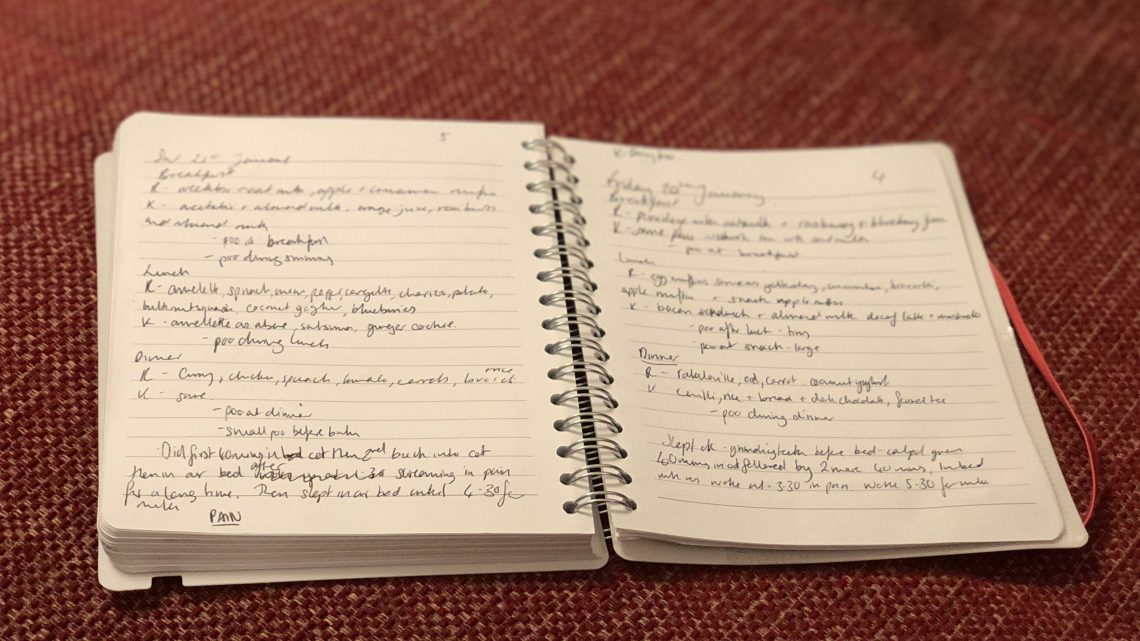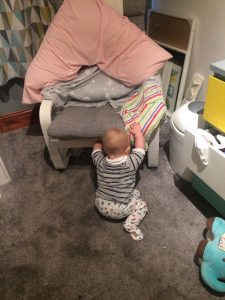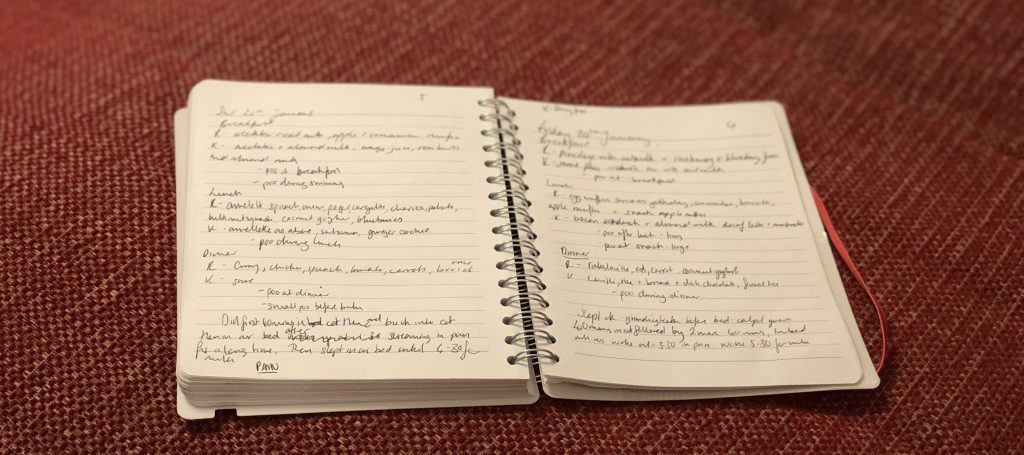
What’s that smell? Episode 6
So here we are… into the heart (or should I say guts) of the diagnosis story; discovering that Piglet was having allergic reactions. However, before I dive straight in, you should know that it’s nowhere near as concrete as you might expect. I’ve spent a lot of time discussing this with my wife and friends in preparation for writing this series, and this post in particular, and what stands out is that nothing’s as clear cut as it might seem. For a start it was about two years ago but even with very specific parts like the food diary – some of the causality seems much less obvious than I expected. Was there a start? Has there been an end? I’ll let you decide for yourself…
As explained in the last episode, we started feeding Piglet solid food just before he turned 6-months. But this post doesn’t really start there. In hindsight, some of the warning signs might have been there from a younger age. Piglet had never been a good sleeper: both daytime naps and overnight sleeps were tough. He was just reluctant to ever be put down on his own.
I’ve never looked into it seriously but I’ve always liked to think I would make a good bomb disposal expert from the patience I learnt from trying to put a sleeping baby down into his cot. Such was the calmness of the gradual transition between ‘baby in arms’ to ‘baby in cot’; I would get pins and needles in my fingers from the cut-off circulation in my arms while I leaned over him, arms still under his head and body, building up the courage to attempt a transfer. Too hurried/juddery and you’d spend the next hour bouncing and rocking the little fragile crying person until you were able to re-attempt disarming.
There can be many reasons for not sleeping well and we certainly didn’t consider allergies to be a part of it at first. (He wasn’t eating any solid food at this stage, any allergens would have being passed through his breast milk, so it was far from our minds). I’ll never know whether it was allergy related or not; but putting Piglet to bed was always a tough task as a starting point. Added to this – he started teething at around 5 months. Not exceptional in itself but it meant he was often quite upset in the evenings and his face would flare up bright red when at its worst. I guess what I’m trying to say is that he wasn’t starting from a perfect comparison place when we started weaning him.

Cute baby, cute sleeping bag, only sleeping in our bed? Not so cute…
I’ve said already that I was slightly nervous when we first fed him milk. But there was no obvious reaction on the back of it. Or at least I was looking for ear aches or swelling throat. Whether he slept well or not that night I have no idea. He was weaned on to just vegetables for the first couple of weeks. It would have been early November 2016 when we started introducing more variety into his diet including (staggered) milk, nuts, gluten, soya etc… I only had reason to be nervous about milk from my own experiences. Any other allergens were just things we’d read to look out for when first introducing to help us be aware of acute allergic reactions.
There was no sudden change (that we noticed) on starting to introduce these new foods. But some of the existing problems seemed to get worse. He’d had baby acne from a very young age – possibly as early as his first week (when he would have been on formula for those 5 days). He also used to get dry patches on the side of his arms (the area you might expect to receive an injection/BCG test). Nappy rash was often quite bad – to the extent we had to find the most medicated creams to make the worst rashes go away. He also used to be a very ‘regular’ baby – we’re talking 6-7 dirty nappies a day and would nearly always go when feeding. All babies are different and we were very eager not to read too much into variances from what might have been considered statistically normal; but, in hindsight, this seemed too much. All of these issues seemed to get worse once he started eating, particularly by December when he had dropped his daytime breastfeeds and moved to 3 ‘meals’ a day.
Sleep had also become more of a problem. Daytime naps rarely lasted more than 30 minutes no matter how tired he was when he went down and he would often wake very upset. Bedtimes were becoming a bit of a battleground as well. Teaching a child to go to sleep is never easy (I can hear Piglet negotiating with mummy upstairs over how many books to read and playing the ‘toilet’ card more times than should really be necessary as I write this… So it’s not like we’ve perfected it now). But Piglet would send himself delirious in his avoidance to go to sleep. We tried everything! Colourful stars. Lights on. Lights off. Music. No music. Singing. Stories. Customising his bed/mattress so that he could sleep at a slight incline… We even wondered if we were being too soft and flirted (without much conviction) with ‘firmer’ parenting strategies such as ‘crying it out’ or variations that didn’t just involving shutting the door on a screaming child and hoping they were still alive in the morning!

Wanna go to bed? No? Ok…
In hindsight – I’m really glad we didn’t persevere with these ‘tactics’. What became clear to us in time was that Piglet was in pain. His tummy was hurting him. A lot. He would lie on his front with his knees brought up to his chest, bottom sticking up in the air. On his back he would arch himself, shoulders pressed into the bed, hips rotated so that his spine is far from the bed as possible. His tummy was hard to the touch and visibly swollen. Oh, and the smell… He had always been a windy baby but it was getting worse and the accompanying smells were getting worse too. In fact, at his worst – lying in bed, he would bring his knees up to his chest and cry/wail as he passed wind. Something clearly wasn’t right.
It’s worth mentioning at this point that by no means was he an unhappy baby. The vast majority of these problems would appear in the late evening/night and to some extent during nap times. When he was busy playing, reading, eating or just interacting you would have no idea that of these things were bothering him. In fact he seemed an incredibly content baby. Granted he would sometimes be teething, or we’d have left it too long before we got his food ready or he was overdue a nap; but otherwise he was a bundle of joy.
So, back to the yoghurt… This had become one of his favourite foods and in the desire to make sure Piglet got lots of protein and calcium etc. we were quite happy to feed him any low-sugar milk products. He hadn’t yet perfected the use of a spoon and we were avoiding feeding him directly, so yoghurt was often eaten with his hand. Specifically scooped up on the skin between his thumb and first finger. The eczema that developed in this area was the first thing that got us researching symptoms.
By December this eczema was appearing in quite sore patches on the back of his knees, upsetting him – and us. I’m not sure what first made me think of it but something in his symptoms reminded me of the discomfort I would get whenever I accidentally consumed cow’s milk. We started to look into it and found the following website: isitcowsmilkallergy.co.uk. I remember my wife and I looking at each other, mouths open, as we looked down the non-IgE list of symptoms: Piglet had virtually every one:
- Colic (excessive and frequent crying)
- Reflux (spitting up during/after feeds)
- Eczema
- Tummy Pain
- Constipation
- Unusual stools
Food refusal is the only item on the list I haven’t included. It seems this particular Piglet was glutton for punishment…
Interestingly, during December – my wife had mentioned some of the symptoms (we didn’t realise they might all be connected at this point) to a health visitor at one of the nurture groups Piglet used to go to. Specifically in relation to his smelliness and the irregularities (or should I say ‘regularities’) of his nappies. Unfortunately at the time my wife was just told, “some babies are just more windy than others”. Even then, not knowing what we do now, we were frustrated by the lack of support. On finding such a relevant list of symptoms we decided that we needed to take Piglet off Cow’s Milk.
We knew that there were nutritional benefits to keeping Cow’s Milk in his diet and looked into the best alternatives. Interestingly a lot of milk alternatives suggest not being suitable as a milk replacement before 1-years old (rice milk suggests 5-years old!). However, these are on the assumption that cow’s milk is the primary milk in the child’s diet and with Piglet still breastfeeding it was only milk in cooking that we were really looking to replace. Being milk-free myself, I was already on Soya Milk but with my wife not liking the flavour we tended to use Almond Milk in anything shared. We were aware that almond milk can be reasonable for vitamins but contains far less protein that cow’s milk or soya milk so made sure to find other sources for this (nuts, meat etc…)
Piglets symptoms improved but didn’t disappear on removing the cow’s milk from his diet. However having seen an improvement and aware that taking a baby off cow’s milk might present some challenges, we decided we had best visit a doctor to get support and advice on such a decision. I was nervous that it would be a difficult conversation. My memories (partially incorrect it appears in having researched for a previous episode in this serious) were of battles with healthcare professionals to get them to agree to my own diagnosis when I was a child and we were both put off by the interactions with health visitors. However, to my surprise, the conversation was very easy. On hearing the symptoms Piglet presented with, the doctor was happy to agree that removing cow’s milk made sense. There was the usual confusion over what we were using the milk for in the first place as Piglet was being breastfed; but once it was clear that we wouldn’t need an alternative formula milk the doctor advised to proceed as we’d suggested. The one change was an insistence that we used soya milk rather than a nut milk on account of the protein content.
This lasted a week.
Any of the benefits that we had seen by removing cow’s milk were instantly reversed by the introduction of soya milk. Although, strangely, the symptoms were subtly different. Where cow’s milk had seemed to cause diarrhoea and windiness – soya seemed to cause constipation and trapped wind. The result was even more tummy pain. Putting Piglet to sleep became even harder. He could barely lie still and the reaction seemed to even change his behaviour. He became manic and frustrated, lashing out and with a crazed glint in his eye. Something along the lines of Heath Ledger’s ‘Joker’ in Christopher Nolan’s Dark Knight. By the end of January 2017 Piglet was off Cow’s Milk and Soya.
While this helped, it wasn’t the end of the story. As part of the recognition of the allergies it had been suggested that we keep a food diary of everything that my wife and Piglet ate and the symptoms that resulted. Its quite interesting looking back over this food diary, knowing what we know now but didn’t know then. On the 17th January 2017, following a 24-hour period where my wife had eaten Caerphilly cheese (twice), ice-cream and semi-skimmed milk, Piglet is noted to have had the following: 1 dirty nappy of ‘funny consistency’ followed by a night where he woke after 1-hour, then every 10-minutes in our bed, then woke several times around midnight before finally sleeping till 4am. Both sets of waking were accompanied with painful wind. He then woke to feed at 6:25. Four days later, the bottom of the page is just signed off with the word “PAIN”, underlined and in capital letters…

Note the word “PAIN” – Yikes!
It’s crazy to think that the milk a human body makes itself can contain something toxic to their own suckling child. But it can – and I have no doubt that Piglet is affected (sometimes quite acutely) by my wife’s consumption of his allergens. The worst bit is that, because it takes a little while to convert into milk and then stays in the system for a few days, if Piglet and my wife ever eat the same contaminated food it will start as soon as the first evening and then affect him for as much as week before it is out of both their systems. I don’t think my wife ever even considered stopping breastfeeding; she just instantly cut cow’s milk and soya out of her diet.
I don’t think I’ve ever truely appreciated how difficult it must have been (and continues to be) for my wife. I had dealt with some understanding of allergies my entire life: learning what kind of foods are likely to catch us out. But for my wife, she finds that, 9-months into being a parent, suddenly half of the items in the cupboard are off the table (that’s a mixed metaphor if ever there was one). We’ve both made mistakes and felt the guilt of getting it wrong. And we’ve both had to step up our think-skinned persistence of pressing for allergen information in situations we might previously have shirked away from.
It’s not a good feeling when you realise that you’ve fed Piglet something that’s going to give him an allergic reaction. I’ve openly wept watching my son writhe in agony, knowing that I could have prevented it (although I try to hide my distress from him). But sometimes you just have to laugh. I remember, weeks after we’d realised that Piglet was allergic to both milk and soya, cooking a meal for the three of us and deciding to do some green veg to go with it. Opening the fridge and freezer, I decided on broccoli and some frozen edamame beans. It wasn’t until cooking them and watching him eat half his portion that it dawned on me. Edamame beans. Edamame, or Soya – to you and me. I’m literally feeding my son soya beans! It never crossed my mind to check the pack of frozen veg and I was too distracted to make the obvious connection.
There are lots of tricks and tips we’ve learnt to help survive on a dairy and soya-free diet. But I’ll leave that for the next post.
Toodlepips
x
Once again, so wonderful to read about parents experiencing similar issues. I remember with our first, wondering if a whole night of sleep was even possible!